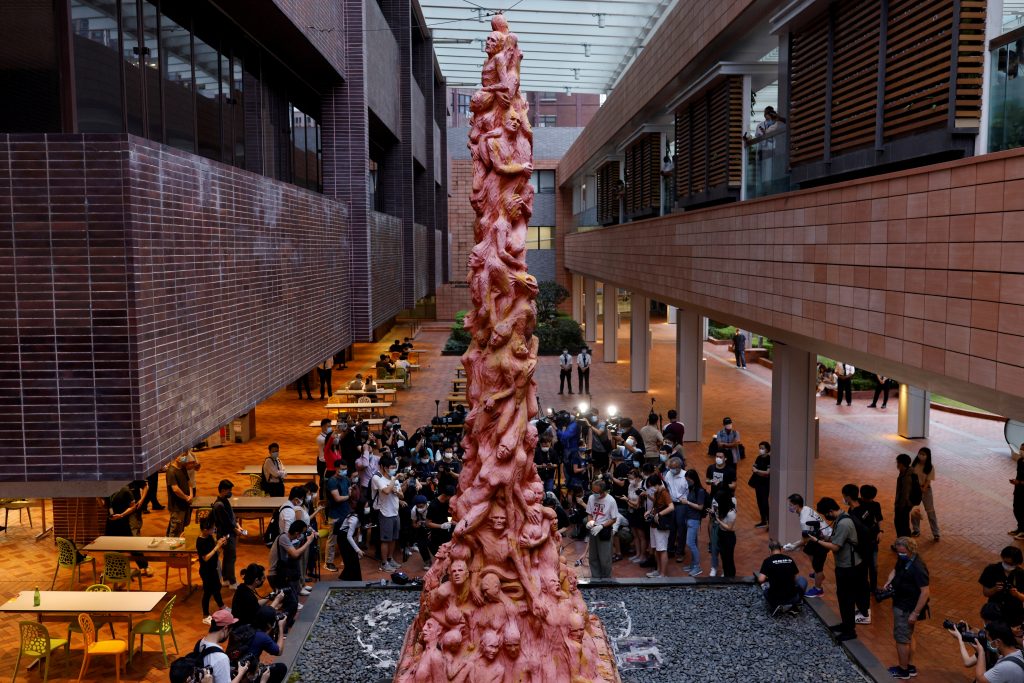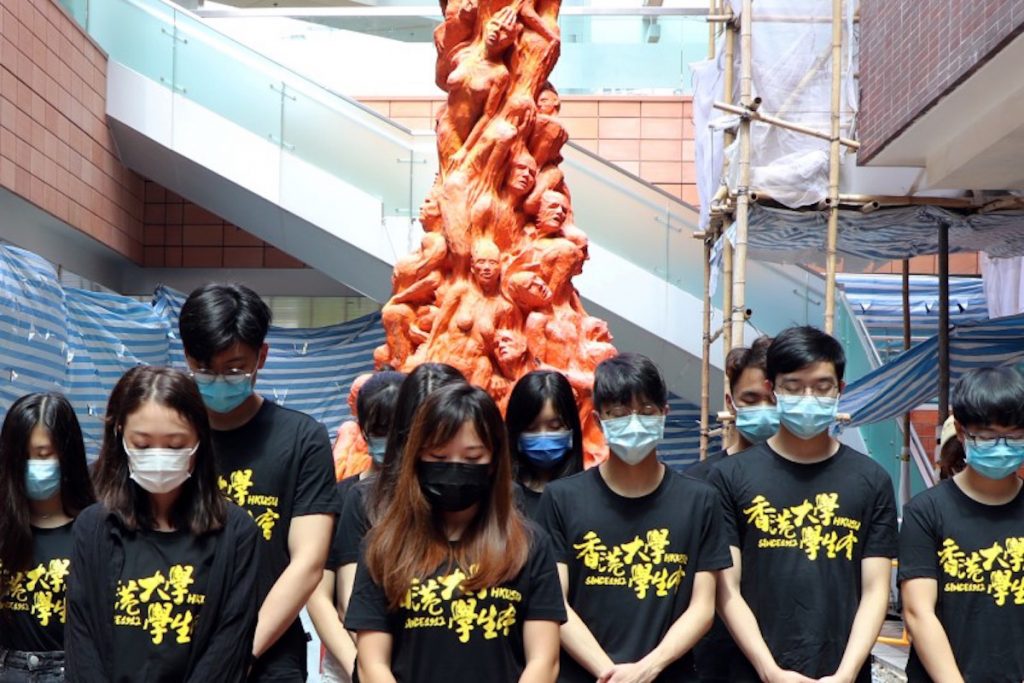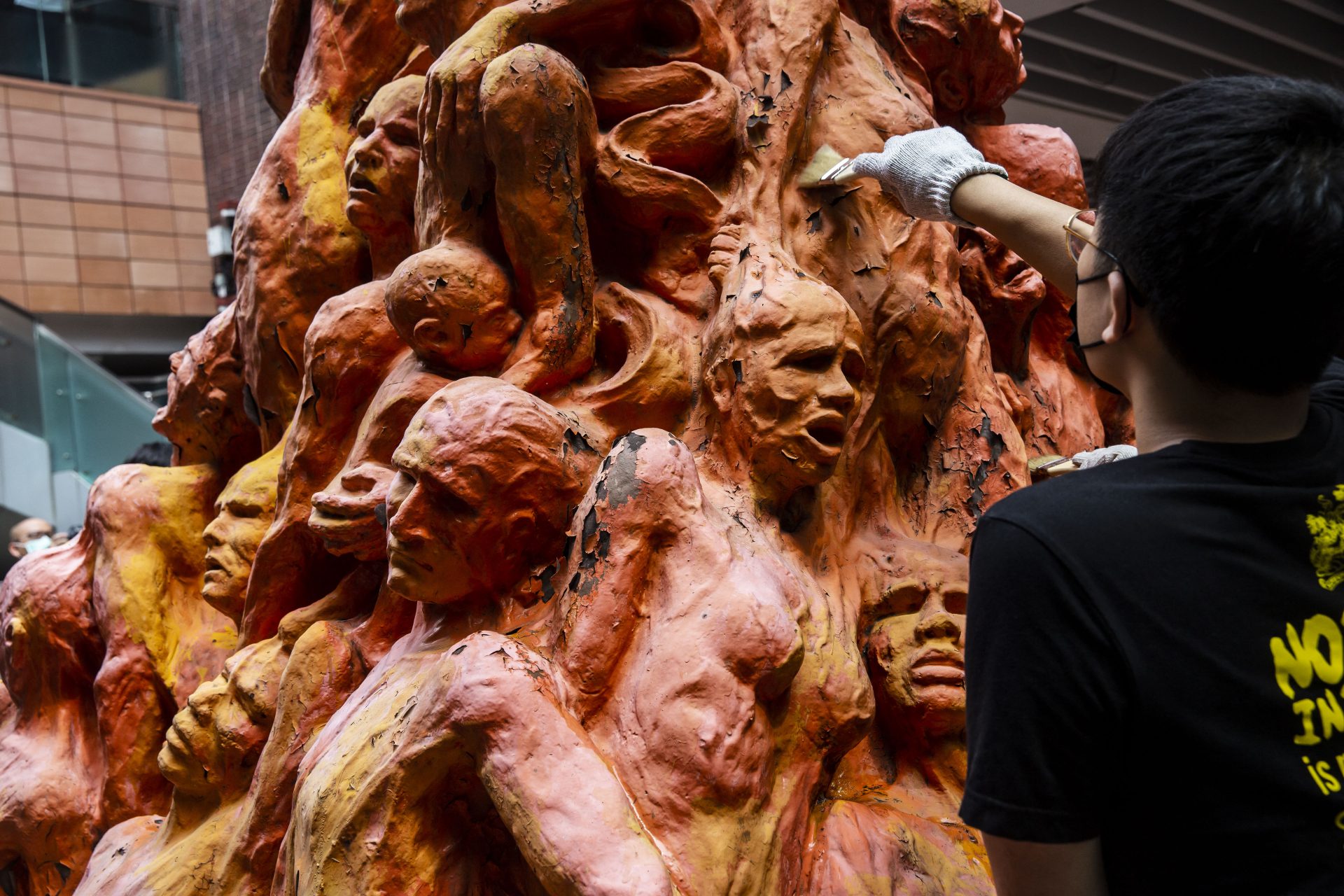Hong Kong police have seized a sculpture by a Danish artist commemorating the victims of the 1989 Tiananmen massacre as evidence of “incitement to subvert state power,” a charge under the national security law.
Police took the two-ton, eight-meter copper “Pillar of Shame” sculpture in honor of the victims of the June 4, 1989, crackdown by the People’s Liberation Army from storage in the northern district of Yuen Long, they said.
“The National Security Department … conducted searches with a warrant this morning. An exhibit related to an ‘incitement to subversion’ case was seized,” police said in a statement, but didn’t clarify whom the charges were being brought against.
“The organization concerned attempted to make misleading comments and request for the return of the exhibit under the guise of artistic freedom, and unreasonably condemned and maliciously smeared the lawful enforcement actions of the Police,” a Security Bureau spokesman said in a statement posted to the government’s website.
The move comes in the run-up to the politically sensitive anniversary of the bloodshed, which was marked for three decades by thousands of people crowded across several soccer pitches in an annual candlelight vigil in Hong Kong’s Victoria Park.
But the event has now been banned amid a citywide crackdown on public dissent and protest under the 2020 national security law.
In December 2001, authorities at the government-run University of Hong Kong removed the “Pillar of Shame” and placed it under guarded storage, saying they had taken “legal advice” regarding potential risks for the university.
Days later, authorities at the Chinese University of Hong Kong took down a 6.4-meter bronze replica of the “Goddess of Democracy” figure used in the Tiananmen Square protests, while Lingnan University removed or painted over two public art works commemorating the victims of the massacre.

Symbolic of wider suppression
Danish sculptor Jens Galschiøt, who created the monument, said he is considering legal action to have his property returned to him.
“In my view they kidnapped my sculpture,” Galschiøt told reporters. “I’m not the person who has [committed] a crime. Hong Kong [University] … have [committed] a crime against private property in Hong Kong.”
Galschiøt said the entire approach to the artwork was symbolic of the suppression of freedom of expression in Hong Kong under an ongoing crackdown by the ruling Communist Party.
“Hong Kong takes a symbol of freedom of expression, puts it in a container, puts a guard around it for one-and-a-half years, and now they’ve moved the same container … to a Hong Kong police station [where] the symbol of the Tiananmen crackdown and the symbol of freedom of expression in Hong Kong is in a sealed container,” he said.
“[The police actions] could be a kind of artwork,” he said. “Maybe this is symbolic of what’s happened in Hong Kong.”
He said the ongoing censorship of public art in Hong Kong was “a big problem for the city.”
Galschiøt said he hasn’t ruled out taking legal action to have the sculpture, which had been on loan to candlelight vigil organizers who had placed it on the University of Hong Kong campus, returned to him.
“This is my private property, and it cost a lot of money, this sculpture,” he said. “So of course if they take and kidnap the sculpture then I will sue them to get it out.”
“There is still a law about private property in Hong Kong. I really hope there is,” he said. “Otherwise they can take your apartment, they can take your money, they can take everything you have, if they take the sculpture.”

‘New low’
A Hong Kong Security Bureau spokesperson linked the seizure of the sculpture to an unnamed “organization” that it accused of trying to “confuse the public, demand the return of relevant evidence under the guise of artistic freedom, and unreasonably condemn and maliciously smear” the legitimate actions of the police, without giving names.
The Prague-based art and cultural non-profit organization NGO DEI, which had been trying to assist Galschiøt with the retrieval of the “Pillar of Shame,” hit out at its seizure by police.
“The government is not only limiting the freedom of artists but also setting a new low point for freedom in Hong Kong,” the group said in a statement on the petition site Change.org.
“Hong Kong should be a culturally diverse and open place that respects artistic freedom, and protecting freedom of speech has always been a core value of Hong Kong people,” it said.
“The government should not limit artistic freedom and should not use the National Security Law to arbitrarily restrict the freedom of speech of Hong Kong people,” it said.
Meanwhile, Hong Kong’s Chinese-language Ming Pao newspaper quoted the Danish foreign ministry as saying that it had raised the matter with Beijing, and that it will continue to provide assistance to retrieve the artwork.
Authorities announced last week that the area of Victoria Park where the vigil was once held would be “closed for maintenance.”
The now-disbanded Hong Kong Alliance in Support of Democratic Patriotic Movements of China led the annual June 4 vigils for more than three decades, the only public commemorations of the 1989 bloodshed to take place on Chinese soil.
The 32-year-old Alliance now stands accused of acting as the agent of a foreign power, with Chow, Albert Ho, and Lee Cheuk-yan all held on suspicion of “incitement to subvert state power,” while the group’s assets remain frozen.
The group was among several prominent civil society groups to disband following investigation by national security police under the national security law that took effect from July 1, 2020.
The annual Tiananmen vigils the Alliance hosted on June 4 often attracted more than 100,000 people, but the gatherings have been banned since 2020, with the authorities citing coronavirus restrictions.







